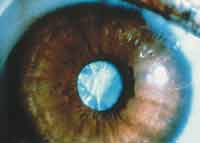Clinical News
MEDICAL AND PRODUCT
UPDATES
TREATING GLAUCOMA
Bimatoprost vs. timolol
Results of a 1-year study comparing the efficacy of bimatoprost 0.03% ophthalmic solution (Lumigan) and timolol maleate 0.5% (Timoptic) indicate that bimatoprost is more effective at lowering intraocular pressure (IOP) in patients with primary open-angle glaucoma or ocular hypertension.
The study, conducted by Eve J. Higginbotham, M.D., of the University of Maryland in Baltimore, involved nearly 600 patients with IOPs between 22 mg Hg and 34 mg Hg.
One group of patients received bimatoprost once a day; a second group received it twice a day; and a third group received timolol twice a day. (Of the two dosages of bimatoprost, once a day turned out to be significantly more effective than twice a day.)
Study results at 1 year indicated:
- Bimatoprost once a day resulted in significantly lower mean IOP than timolol twice a day at every follow-up visit. IOP measured at 10 a.m. (when timolol's effect is at its peak) ranged from 16.1 to 16.8 mm Hg for bimatoprost, and 17.9 to 18.7 mm Hg for timolol.
- Bimatoprost once a day provided greater mean IOP reductions from baseline than timolol at all follow-up visits. At month 12, mean IOP reduction from baseline at 10 a.m. was 32% for bimatoprost, and 23% for timolol.
- Significantly higher percentages of patients achieved target IOPs with bimatoprost than timolol.
- In terms of safety, 4.3% of bimatoprost patients discontinued because of adverse events, compared to 6.7% of timolol patients. The most frequent side effects in the bimatoprost once-a-day group were conjunctival hyperemia and eyelash growth. Bimatoprost caused changes in iris pigmentation in 1.7% of patients, but had no significant effects on systemic variables such as blood pressure or chemistry. (Timolol has been associated with occasional cardiopulmonary side effects.)
RESTORING VISION
A nonsurgical treatment for cataract blindness
Dr. Louis J. Girard, a former professor and chairman of ophthalmology at the Baylor College of Medicine, Houston, is close to developing a way to displace a cataractous lens below the pupil by putting enzymatic drops in a patient's eye. Combined with an inexpensive pair of glasses, this would provide a cost-effective way to restore vision to many of the 18 million people in developing countries who've been blinded by cataracts. (Sheer numbers -- and the cost factor -- preclude surgical solutions.) Dr. Girard's approach would cost 3 U.S. dollars per person, and could be applied by nonophthalmologists.

A group of chemists from Rice University has been working for 4 years to develop a zonulolytic agent that can pass through the cornea when instilled in the eye as a drop. According to Dr. Girard, they're close to succeeding.
The Girard Ophthalmological Foundation, created by Dr. Girard, has been supporting the project, but is running out of money. Dr. Girard hopes to raise $1 million to see the project through to completion -- and perhaps restore vision to millions of people around the world.
HYPEROPIA CORRECTION
Intracorneal lens approved
in Europe
A lens designed to be implanted underneath a corneal flap has received approval for commercial distribution throughout the European Union. The PermaVision intracorneal lens, developed by Anamed, Inc., a California biomedical technology company, can correct hyperopia up to +6 diopters.
To place the lens in the cornea, the surgeon creates a hinged flap like the one created during LASIK. The flap is lifted, the lens is centered on the pupil and the flap is folded back over the lens. Fluid dynamics keep the lens and flap in place; no stitches are necessary. Some surgeons consider this procedure ideal because the lens can be replaced or removed and no tissue is ablated.
The procedure, under development for more than 50 years, awaited a lens material with the right characteristics. Anamed finally developed a substance that mimics the water content, refractive index, optical clarity, fluid transport, and metabolite and oxygen permeability of the stroma, called Nutrapore.
An international, multicenter clinical trial of the procedure has been under way since December 1999, and an FDA trial will begin this fall.








